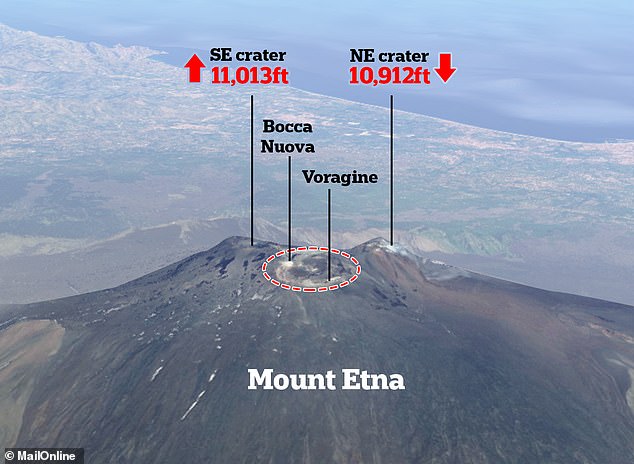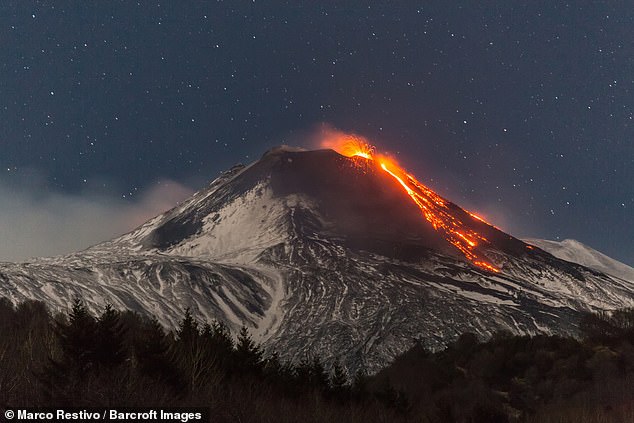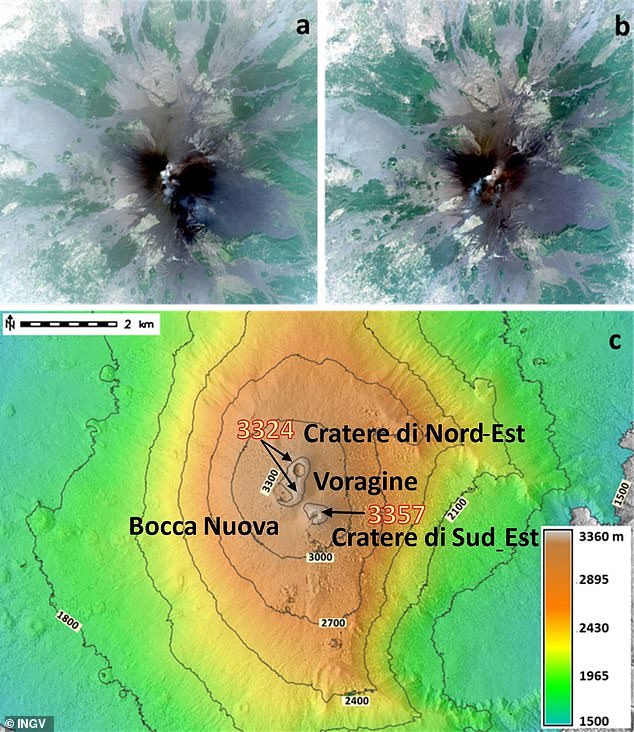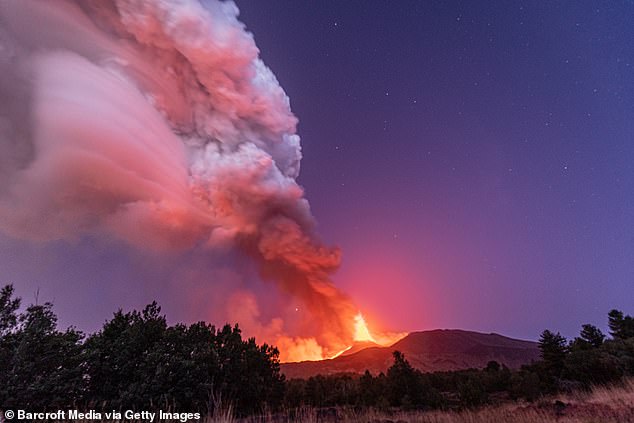Mount Etna has grown in height to a record 11,013ft after six months of activity, according to Italy’s volcano monitoring agency.
Experts said the southeast and youngest crater of Europe’s most active volcano is now much higher than its ‘older brother’, the northeast crater, which was the ‘undisputed peak of Etna’ for 40 years.
Some 50 episodes of ash and lava have been belching from the mouth of the crater since mid-February, the National Institute for Geophysics and Volcanology (INGV) said, giving Etna a new peak.
Scroll down for video

Mount Etna has grown in height to a record 11,013ft after six months of activity, according to Italy’s volcano monitoring agency. Experts said the southeast and youngest crater of Europe’s most active volcano is now much higher than its ‘older brother’, the northeast crater (pictured)

Each year, Etna produces around 7.7 million tons of carbon dioxide, water and sulphur dioxide

The southeastern crater is shown here on the graphic and in satellite images above along with the other three craters at Etna’s summit: the northeastern, West Chasm or Bocca Nuova (new mouth) and the central Voragine craters
How can researchers predict volcanoes?
According to Eric Dunham, an associate professor of Stanford University’s School of Earth, energy and Environmental Sciences, ‘Volcanoes are complicated and there is currently no universally applicable means of predicting eruption. In all likelihood, there never will be.’
However, there are indicators of increased volcanic activity, which researchers can use to help predict volcanic eruptions.
Researchers can track indicators such as:
Volcanic infrasound: When the lava lake rises up in the crater of an open vent volcano, a sign of a potential eruption, the pitch or frequency of the sounds generated by the magma tends to increase.Seismic activity: Ahead of an eruption, seismic activity in the form of small earthquakes and tremors almost always increases as magma moves through the volcano’s ‘plumbing system’.Gas emissions: As magma nears the surface and pressure decreases, gases escape. Sulfur dioxide is one of the main components of volcanic gases, and increasing amounts of it are a sign of increasing amounts of magma near the surface of a volcano. Ground deformation: Changes to a volcano’s ground surface (volcano deformation) appear as swelling, sinking, or cracking, which can be caused by magma, gas, or other fluids (usually water) moving underground or by movements in the Earth’s crust due to motion along fault lines. Swelling of a volcano cans signal that magma has accumulated near the surface.
Source: United States Geological Survey
Advertisement
The northeastern crater of Etna reached a record height of 10,990ft in 1981, but a collapse at its edges reduced that to 10,912ft, recorded in 2018.
Satellite suggest the southeast crater has now surpassed that and stands at 11,013ft.
Etna is Europe’s most active volcano, producing enough lava every year to fill a 108-story skyscraper.
It has been churning out smoke and ash since February, dirtying streets, slowing traffic and damaging crops.
Although it poses little danger to surrounding villages, Sicily’s government estimated in July that 300,000 metric tones of ash had so far been collected as part of the clean-up operation.
The INGV, based in the Sicilian city of Catania, said this increase in volcanic activity had led to a ‘conspicuous transformation of the volcano’s outline’.
‘Thanks to the analysis and processing of satellite images, the southeast crater is now much higher than its “older brother”, the northeast crater, for 40 years the undisputed peak of Etna,’ the INGV wrote in a press release.
‘The summit of Etna, since 1980, has always been considered the northeast crater which, with the paroxysms of September 1980 and February 1981, reached a maximum height of 3,350m (10,990ft).
‘This height, which has decreased over the years due to the collapse of its edges, in the summer of 2018 settled at 3,326m (10,912ft).
‘This record, however, has now been surpassed by the cone of the southeast crater and, today, Etna has a new peak.’
The 700,000-year-old volcano is the second most active on Earth, after Hawaii’s Mount Kilauea.
Situated between the African and Eurasian tectonic plates, it generates nearly constant eruptions of varying degrees.
Each year it produces more than tens of million tons of lava and over 7 million tons of carbon dioxide, water and sulfur dioxide.
It’s most severe recent eruption occurred in March of 2017, when nearly a dozen people were injured.
But eruptions have been recorded as far back as 1500 BC, with a devastating eruption in 1169 causing an earthquake that killed an estimated 15,000 people.

Some 50 episodes of ash and lava have been belching from the mouth of the crater since mid-February, the National Institute for Geophysics and Volcanology said, giving Etna a new peak

Europe’s most famous volcano was already known to be edging slowly towards the Mediterranean. But a new analysis shows the movement is mainly being driven by it collapsing under its own weight – a phenomenon known as ‘gravitational instability’
Research from 2018 revealed that Mount Etna is slowly sliding into the sea and when it finally goes it could trigger a tsunami.
It was already known to be edging slowly towards the Mediterranean, but the analysis showed the movement is mainly being driven by it collapsing under its own weight — a phenomenon known as ‘gravitational instability’.
This has caused one of the sides of the notorious mountain on the east coast of Sicily to weaken, increasing the risk of a devastating tidal wave.
Previously it had been assumed the lava bubbling inside was the root cause of the volcano’s movement.
Separately, scientists have also argued that the title of the world’s highest mountain should go to a volcanic peak in Ecuador, rather than Everest.
HOW EARTH’S ‘HIGHEST’ MOUNTAINS MEASURE UP Mount Everest Mount Chimbarazo Location Himalayas, Nepal and Tibet Cordillera Occidental, Equador Height above sea level 29,029 feet 20,500 feet Height from centre of Earth 3,965 miles 3,967 miles Average climbing time 40 days from base camp 14 days First ascent 1953 1802
They said in 2016 that when measured from the centre of the planet, Mount Chimborazo extends further out into the atmosphere than Mount Everest.
This is because the Earth is not a perfect sphere and bulges around the equator.
When measured from sea level, Mount Chimborazo, which rises 20,500 feet, falls short of Everest by 8,529 feet, which stands at a mighty 29,029 feet.
But when measured from the centre of the Earth, researchers at the Institut de Recherche pour le Développement in France confirmed that Chimborazo’s apex reaches 3,967 miles.
Everest, by comparison, does not even make the cut for the Earth’s top 20 highest mountains, measuring 3,965 miles from the planet’s centre.
Source link : https://www.dailymail.co.uk/sciencetech/article-9883177/Mount-Etna-volcano-risen-record-11-013ft.html












